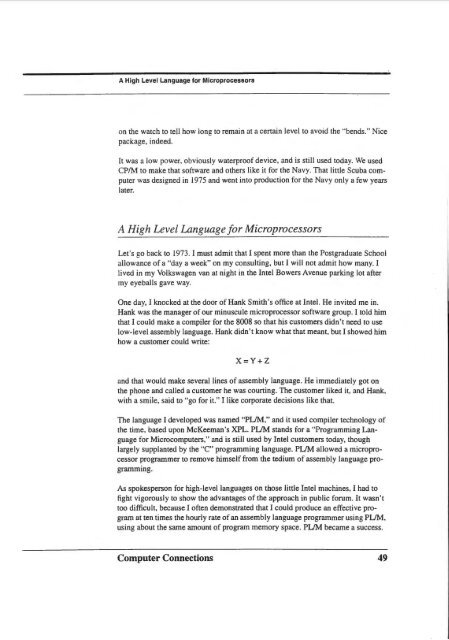appreciate
kildall-p.1-78-publishable-lowres
kildall-p.1-78-publishable-lowres
Create successful ePaper yourself
Turn your PDF publications into a flip-book with our unique Google optimized e-Paper software.
A High Level Language for Microprocessors<br />
on the watch to tell how long to remain at a certain level to avoid the "bends." Nice<br />
package, indeed.<br />
It was a low power. obviously waterproof device, and is still used today. We used<br />
CP/M to make that software and others like it for the Navy. That little Scuba computer<br />
was designed in 1975 and went into production for the Navy only a few years<br />
later.<br />
A High Level Language for Microprocessors<br />
Let's go back to 1973. I must admit that I spent more than the Postgraduate School<br />
allowance of a "day a week" on my consulting, but I will not admit how many. I<br />
lived in my Volkswagen van at night in the Intel Bowers Avenue parking lot after<br />
my eyeballs gave way.<br />
One day, I knocked at the door of Hank Smith's office at Intel. He invited me in.<br />
Hank was the manager of our minuscule microprocessor software group. I told him<br />
that I could make a compiler for the 8008 so that his customers didn't need to use<br />
low-level assembly language. Hank didn't know what that meant, but I showed him<br />
how a customer could write:<br />
X=Y+Z<br />
and that would make several lines of assembly language. He immediately got on<br />
the phone and called a customer he was courting. The customer liked it, and Hank,<br />
with a smile, said to "go for it." I like corporate decisions like that.<br />
The language I developed was named "PUM," and it used compiler technology of<br />
the time, based upon McKeeman's XPL. PIJM stands for a "Programming Language<br />
for Microcomputers," and is still used by Intel customers today, though<br />
largely supplanted by the "C" programming language. PUM allowed a microprocessor<br />
programmer to remove himself from the tedium of assembly language programming.<br />
As spokesperson for high-level languages on those little Intel machines, I had to<br />
fight vigorously to show the advantages of the approach in public forum. It wasn't<br />
too difficult, because I often demonstrated that I could produce an effective program<br />
at ten times the hourly rate of an assembly language programmer using PUM,<br />
using about the same amount of program memory space. PUM became a success.<br />
Computer Connections 49


